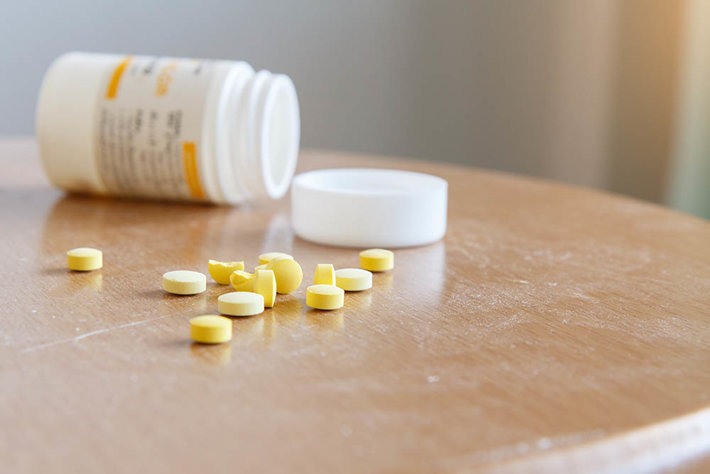Signs and Symptoms of Prescription Pain Reliever Abuse

In the US and Canada, pain relievers are the most frequently abused type of prescription drug. Europe shows some signs of catching up to the US, as fentanyl, the extremely strong painkilling opiate, is seeing more abuse. In other countries, it may be benzodiazepines as is seen in Northern European countries like Finland and Norway. In Asian countries, it is more likely to be stimulants such as prescription amphetamine.
A person bent on abusing an opiate or an opioid (a synthetic drug chemically similar to a derivative of opium) has plenty of choices.
- Hydrocodone, often combined with acetaminophen, as in Vicodin or Lortab.
- Oxycodone, most commonly prescribed as OxyContin but also seen in Endocet, Percocet, Percodan and Roxicet.
- Morphine
- Codeine, often given for severe coughs.
- Propoxyphene sold as Darvon
- Hydromorphone sold as Dilaudid
- Meperidine sold as Demerol
Opiates and opioids are very addictive. Many people progress to abuse and addiction after starting to take them as prescribed. Other people take them recreationally from the start. Either route leads to addiction and can easily lead to an overdose death.
It is said that opiate pain relievers provide a high that is similar to that of heroin. Ironically, abusing prescription pain relievers now leads many people to heroin. As state after state enacts laws making it difficult to acquire supplies of prescription drugs for illicit use, many people have been turning to heroin, leading to more demand for heroin addiction treatment and more overdose deaths.
Prescription Pain Reliever Abuse Help
It is wise for families to know what it looks like when someone abuses prescription pain relievers so they can get that person help before their life is ruined.
Signs to Look For
A person who is abusing opiates will have constricted pupils, will appear tired and drowsy. They may actually nod out but continue to try to talk as they don’t realize they have nodded out.
A person early in their abuse of these drugs may get itchy and nauseated. As the drug kicks in, he or she may vomit.

A person who has been crushing pills and snorting them may leave short straws and rolled dollar bills around, along with small mirrors. If they smoke the drug, there may be pipes left around, and if they inject it, there may be syringes, rubber tubes, syringe caps, droppers.
While intoxicated on opiates, the person may show these signs:
- Reduced social interaction
- Drowsiness
- Poor memory and concentration
- Anxiety
- Constipation (may try to acquire remedies)
- Slowed breathing
- Slow movement and reactions
- Mood swings
- Apathy and depression.
Once the person becomes dependent on the opiate, there will start to be lifestyle and behavioral changes.
Lifestyle and Behavioral Changes:
- Whatever money they have will go for drugs so they may not have required items that they would normally be expected to have.
- Alternately, as some people begin to sell drugs to support their addiction, they may have unexpected money or expensive items.
- They will begin to be preoccupied with obtaining drugs and maintaining their addiction and so will drop out of touch with family and friends. They may have a whole new set of friends who are drug users.
- They may commit illegal acts to get money for drugs and may be arrested.
- They probably will begin to neglect work and school.
- They may show a change in overall attitude and have outbursts of bad temper.
- The person may talk about partying or drinking more than before.
- The person may appear jittery and be secretive.
- They are likely to allow grooming and physical appearance to deteriorate.
- Loans of money may be asked for and items from the homes of family members may go missing.
- Long sleeved clothes may be worn if the person is an intravenous drug user.
The Nature of Addiction Means that Most Addicts Will Reject Help
Most addicts feel that they only way they can feel normal or enjoy anything in life is to be high. If someone tries to help them break free from their addiction, the addicted person is very likely to deny the problem, make excuses or promise to do better—without ever delivering on that promise.
Many of those addicted to opiates will need addiction recovery help to leave drugs behind. One of the ways that Narconon can help addicted people, in addition to proving lasting sobriety from their effective drug rehabilitation program, is by helping send an interventionist into this situation. A professional interventionist can help the addicted person find the desire in his or her heart to be free from drugs and agree to go to rehab.
One phase of addiction treatment at a Narconon rehab facility, the Narconon New Life Detoxification, provides the right combination of moderate exercise, nutritional supplementation and time in a low-heat sauna to flush out old drug toxins. As these toxins can be involved in the triggering of cravings, this is an essential step on the way to a new, sober life.
Resources:
 ®
®